Features
The Ongoing Saga of Sutton Hoo
By JASON URBANUS
Thursday, January 14, 2021
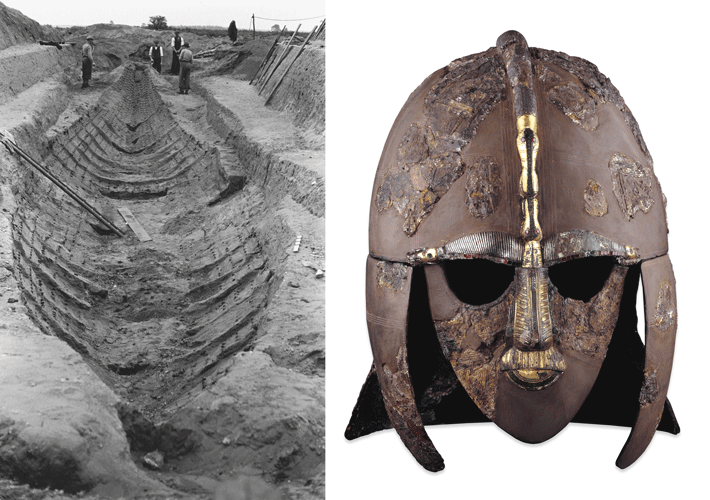 The small English village of Rendlesham, Suffolk, sits just four miles upriver to the northeast of the famed Anglo-Saxon royal burial site of Sutton Hoo. Portions of the modern village and its fields had long attracted the notice of archaeologists, and had been investigated during the nineteenth century, in the 1940s, and as recently as 1982. Evidence from these studies, though relatively scant, established that it had been an Anglo-Saxon settlement, but not necessarily with a royal connection. Then, in 2008, a Rendlesham landowner notified authorities that “nighthawks”—metal detectorists who raid archaeological sites in darkness, searching out illicit treasure—had been scouring his fields.
The small English village of Rendlesham, Suffolk, sits just four miles upriver to the northeast of the famed Anglo-Saxon royal burial site of Sutton Hoo. Portions of the modern village and its fields had long attracted the notice of archaeologists, and had been investigated during the nineteenth century, in the 1940s, and as recently as 1982. Evidence from these studies, though relatively scant, established that it had been an Anglo-Saxon settlement, but not necessarily with a royal connection. Then, in 2008, a Rendlesham landowner notified authorities that “nighthawks”—metal detectorists who raid archaeological sites in darkness, searching out illicit treasure—had been scouring his fields.
The renewed attention brought by the looters enabled the Suffolk County Council Archaeological Service, working with the landowner and volunteer metal detectorists, to conduct a survey, led by archaeologist Jude Plouviez, to evaluate damage and reassess the site’s archaeological potential. Now, some six years later, the investigation is ongoing, and the fields of Rendlesham are helping to fill in our knowledge of the kingdom that the Anglo-Saxon royals of Sutton Hoo once presided over. While the magnificent burials, which date from the sixth and seventh centuries, bring to mind romantic images of warriors such as Beowulf, recent archaeological fieldwork is providing scholars with a new and fuller view of Anglo-Saxon life.
Sutton Hoo is located in eastern England in an area known as East Anglia. The name derives from the people known as the Angles, a Germanic tribe that began invading and settling in Britain around the fifth century. The East Angles were among the largest and most powerful of the Anglo-Saxon tribes, ruling from centers located along the coast and river valleys in present-day East Anglia. It was there, on a small rise above the River Deben, at Sutton Hoo, that the rulers and royal families of the East Angles were laid to rest.
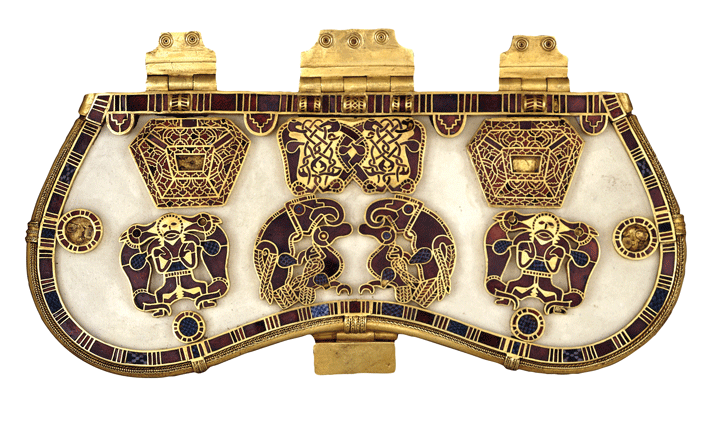
The Neolithic Toolkit
By ANDREW CURRY
Tuesday, October 14, 2014
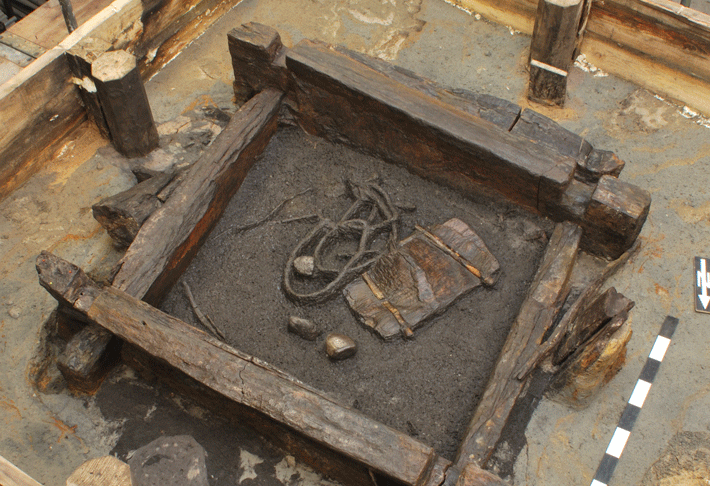
Not too long ago, archaeologist Rengert Elburg found something that convinced him that “Stone Age sophistication” is not a contradiction in terms. It was a wood-lined well, discovered during construction work in Altscherbitz, near the eastern German city of Leipzig. Buried more than 20 feet underground, preserved for millennia by cold, wet, oxygen–free conditions, the timber box at the bottom of the well was 7,000 years old—the world’s oldest known intact wooden architecture.
Elburg’s team at the Saxony State Archaeological Office removed the ancient well in a single 70-ton block, and brought it back to their lab in Dresden for careful excavation, documentation, and preservation. There, they recovered 151 timbers from the well, which, during the Neolithic period, was part of a large settlement that included nearly 100 timber longhouses. Even after so many millennia, the well’s extraordinary state of preservation began to give the researchers clues to the tools and techniques the ancient woodworkers used. They learned, for example, that to reinforce the bottom of the well, prehistoric carpenters had fashioned boards and beams from old-growth oaks three feet thick, then fit them together using tusked mortise-and-tenon joints, a technique not seen again until the Roman Empire, five millennia later.
When Elburg examined the wood, he could see not only tree rings but also tool marks. But with nothing to compare these ancient tool marks to, this evidence was hard to understand. Thus, he and a motley collection of archaeologists, amateur woodworkers, historical reenactors, and flintknapping hobbyists have been gathering each spring since 2011 for a most unusual workshop. Held in a forest just outside the town of Ergersheim in the southern German region of Franconia, it’s experimental archaeology with a serious purpose.
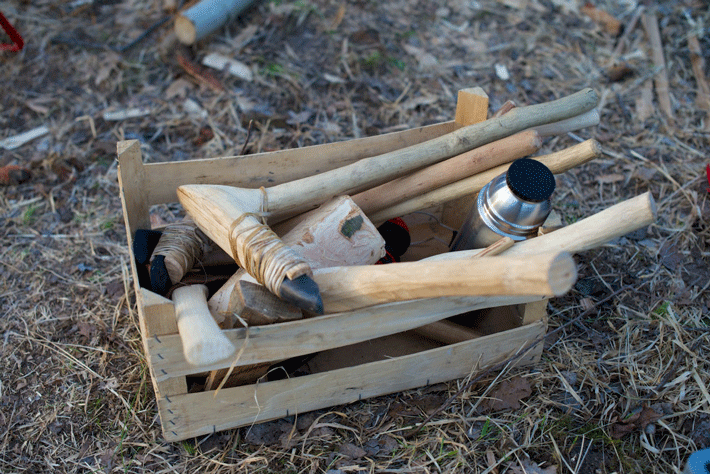 On the first full day of the 2014 workshop, a late-March Saturday, the woods are the dull brown of dead leaves, with a few tiny white flowers emerging to greet the unseasonably warm sun. It’s easy to spot the workshop participants—they’re all wearing red T-shirts emblazoned with an adze-wielding beaver. Elburg’s brought along a Stone Age woodworking toolkit fashioned by freelance archaeo-technician Wulf Hein, who uses the replica tools he makes to create copies of ancient artifacts. After less than an hour of hacking away at a sturdy, decades-old oak donated by the local authorities, a glancing blow has shattered the sharp end of a basalt wedge, rendering it unusable. Red T-shirts cluster around Elburg as he declares the wedge—a 5.5-pound triangle of stone with a hole in the broad end, attached to a slender wood handle—unsalvageable. It’s one of only a handful they have along. “That’s really a shame,” the archaeologist says with a grimace. “That one was really nicely carved. Too bad. Time for another broad wedge, I guess.”
On the first full day of the 2014 workshop, a late-March Saturday, the woods are the dull brown of dead leaves, with a few tiny white flowers emerging to greet the unseasonably warm sun. It’s easy to spot the workshop participants—they’re all wearing red T-shirts emblazoned with an adze-wielding beaver. Elburg’s brought along a Stone Age woodworking toolkit fashioned by freelance archaeo-technician Wulf Hein, who uses the replica tools he makes to create copies of ancient artifacts. After less than an hour of hacking away at a sturdy, decades-old oak donated by the local authorities, a glancing blow has shattered the sharp end of a basalt wedge, rendering it unusable. Red T-shirts cluster around Elburg as he declares the wedge—a 5.5-pound triangle of stone with a hole in the broad end, attached to a slender wood handle—unsalvageable. It’s one of only a handful they have along. “That’s really a shame,” the archaeologist says with a grimace. “That one was really nicely carved. Too bad. Time for another broad wedge, I guess.”
|
Video:
|
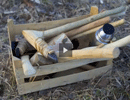
Recreating The Neolithic Toolkit
|
Dawn of a Thousand Suns
By SAMIR S. PATEL (Additional Reporting by BARRY YEOMAN)
Tuesday, October 28, 2014
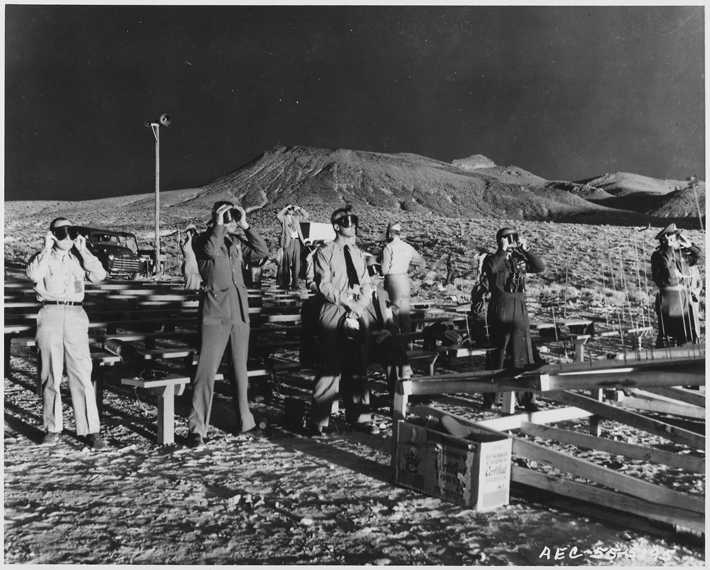
The time: 1955. The place: a dry lakebed in southern Nevada called Frenchman Flat. An explosion equivalent to 22,000 tons of TNT creates a roiling mass of superheated, low-density gas. This fireball rises and collides with the surrounding air, creating turbulent vortices that suck smoke and debris up from the ground into a column. The “stem” rises into cooler, thinner air, where the ascent slows, debris disperses, and moisture condenses to form a “cap.” Over days and even months, nuclear fallout spreads and drifts to Earth.
Between 1951 and 1962, well after the detonations at Hiroshima and Nagasaki, 14 mushroom clouds rose above this corner of the Nevada desert. They were part of a long, complex, and varied program of nuclear testing, and each had a broad audience. One part was global, as the Cold War superpowers, the United States and the Soviet Union, squared off; the other was sitting on benches on an overlook seven miles away. A stream of political and military VIPs sat there, squinting at blasts and being buffeted by powerful shockwaves. Today, 11 rows of the benches sit under the desert sun, with nails jutting from their warped, desiccated planks. “I like these benches,” says Colleen Beck, an archaeologist with the Desert Research Institute (DRI), part of the Nevada System of Higher Education. “While hardly anyone comes here now, you can really imagine people sitting on them, watching a test.”
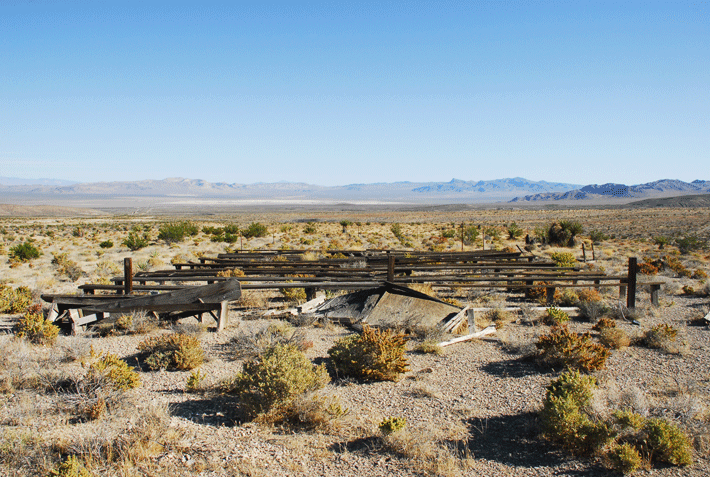 Frenchman Flat is one of 14 historic districts at what was once called the Nevada Test Site (now the Nevada National Security Site), 1,360 square miles of dust, scrub, and mesa managed by the U.S. Department of Energy. This battlefield that never saw a battle was a main source of the heat of the Cold War. All told, more than 1,000 nuclear weapons were detonated at the Test Site—aboveground and in tunnels—over more than 40 years. Material from these experiments is scattered across the landscape. Each squat building, twisted hunk of metal, and heavily gated tunnel entrance reflects the need both to understand a new, utterly alien power—and to project a mastery of that power to the rest of the world. Beck and her colleagues at the DRI, under contract with the Department of Energy, have spent two decades cataloguing and studying these diverse remains—the rusted wreckage of towers that held bombs, seemingly mundane research support areas, instruments from specific experiments, mock suburban homes. The Test Site offers a complex archaeology of science and war, of geopolitics and popular culture.
Frenchman Flat is one of 14 historic districts at what was once called the Nevada Test Site (now the Nevada National Security Site), 1,360 square miles of dust, scrub, and mesa managed by the U.S. Department of Energy. This battlefield that never saw a battle was a main source of the heat of the Cold War. All told, more than 1,000 nuclear weapons were detonated at the Test Site—aboveground and in tunnels—over more than 40 years. Material from these experiments is scattered across the landscape. Each squat building, twisted hunk of metal, and heavily gated tunnel entrance reflects the need both to understand a new, utterly alien power—and to project a mastery of that power to the rest of the world. Beck and her colleagues at the DRI, under contract with the Department of Energy, have spent two decades cataloguing and studying these diverse remains—the rusted wreckage of towers that held bombs, seemingly mundane research support areas, instruments from specific experiments, mock suburban homes. The Test Site offers a complex archaeology of science and war, of geopolitics and popular culture.
Advertisement
DEPARTMENTS
Also in this Issue:
Advertisement
IN THIS ISSUE
Features
Dawn of a Thousand Suns
The Neolithic Toolkit
The Ongoing Saga of Sutton Hoo
Letter From Montana
Advertisement

Recent Issues
-
 May/June 2024
May/June 2024
-
 March/April 2024
March/April 2024
-
 January/February 2024
January/February 2024
-
 November/December 2023
November/December 2023
-
 September/October 2023
September/October 2023
-
 July/August 2023
July/August 2023
-
 May/June 2023
May/June 2023
-
 March/April 2023
March/April 2023
-
 January/February 2023
January/February 2023
-
 November/December 2022
November/December 2022
-
 September/October 2022
September/October 2022
-
 July/August 2022
July/August 2022
-
 May/June 2022
May/June 2022
-
 March/April 2022
March/April 2022
-
 January/February 2022
January/February 2022
-
 November/December 2021
November/December 2021
-
 September/October 2021
September/October 2021
-
 July/August 2021
July/August 2021
-
 May/June 2021
May/June 2021
-
 March/April 2021
March/April 2021
-
 January/February 2021
January/February 2021
-
 November/December 2020
November/December 2020
-
 September/October 2020
September/October 2020
-
 July/August 2020
July/August 2020
-
 May/June 2020
May/June 2020
-
 March/April 2020
March/April 2020
-
 January/February 2020
January/February 2020
-
 November/December 2019
November/December 2019
-
 September/October 2019
September/October 2019
-
 July/August 2019
July/August 2019
-
 May/June 2019
May/June 2019
-
 March/April 2019
March/April 2019
-
 January/February 2019
January/February 2019
-
 November/December 2018
November/December 2018
-
 September/October 2018
September/October 2018
-
 July/August 2018
July/August 2018
-
 May/June 2018
May/June 2018
-
 March/April 2018
March/April 2018
-
 January/February 2018
January/February 2018
-
 November/December 2017
November/December 2017
-
 September/October 2017
September/October 2017
-
 July/August 2017
July/August 2017
-
 May/June 2017
May/June 2017
-
 March/April 2017
March/April 2017
-
 January/February 2017
January/February 2017
-
 November/December 2016
November/December 2016
-
 September/October 2016
September/October 2016
-
 July/August 2016
July/August 2016
-
 May/June 2016
May/June 2016
-
 March/April 2016
March/April 2016
-
 January/February 2016
January/February 2016
-
 November/December 2015
November/December 2015
-
 September/October 2015
September/October 2015
-
 July/August 2015
July/August 2015
-
 May/June 2015
May/June 2015
-
 March/April 2015
March/April 2015
-
 January/February 2015
January/February 2015
-
 November/December 2014
November/December 2014
-
 September/October 2014
September/October 2014
-
 July/August 2014
July/August 2014
-
 May/June 2014
May/June 2014
-
 March/April 2014
March/April 2014
-
 January/February 2014
January/February 2014
-
 November/December 2013
November/December 2013
-
 September/October 2013
September/October 2013
-
 July/August 2013
July/August 2013
-
 May/June 2013
May/June 2013
-
 March/April 2013
March/April 2013
-
 January/February 2013
January/February 2013
-
 November/December 2012
November/December 2012
-
 September/October 2012
September/October 2012
-
 July/August 2012
July/August 2012
-
 May/June 2012
May/June 2012
-
 March/April 2012
March/April 2012
-
 January/February 2012
January/February 2012
-
 November/December 2011
November/December 2011
-
 September/October 2011
September/October 2011
-
 July/August 2011
July/August 2011
-
 May/June 2011
May/June 2011
-
 March/April 2011
March/April 2011
-
 January/February 2011
January/February 2011
Advertisement





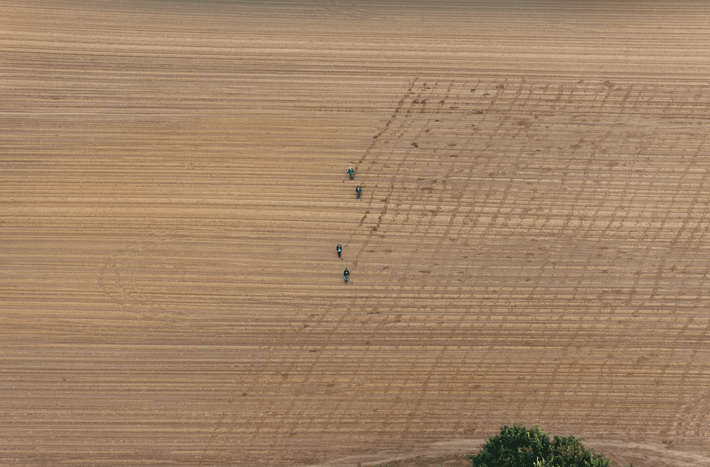
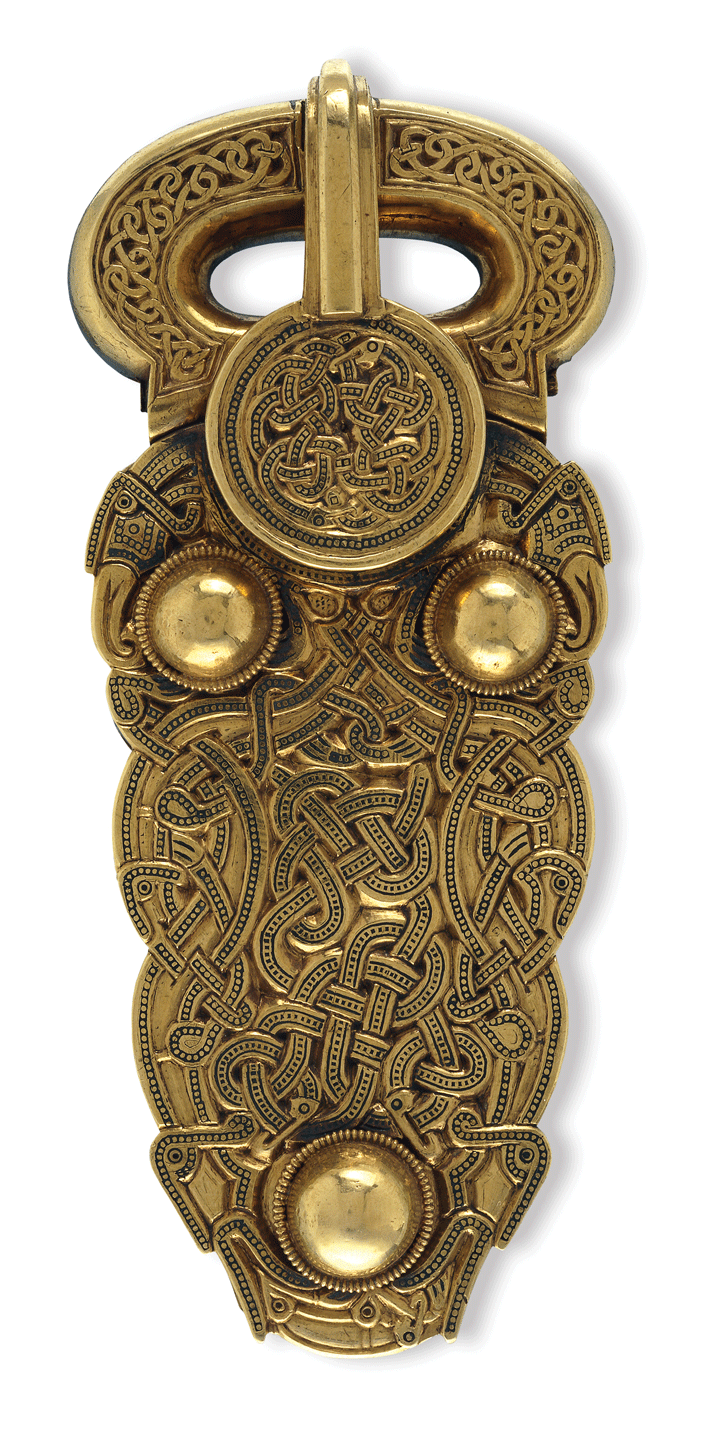 Although almost nothing remained of its original wooden framework, over the course of 1,300 years, the ship’s rotting timbers left a perfect impression in the soil, allowing archaeologists to determine its exact design and size. The burial chamber was furnished with gold and garnet jewelry, silver bowls, coins, drinking horns, iron swords and spears, and a stunning warrior helmet and facemask, which, with its tinned bronze and gilt decoration, has become the iconic symbol of Anglo-Saxon archaeology. Many experts have concluded, based on the richness of the grave goods and the size of the ship, that the tomb is that of Rædwald, the most powerful king of East Anglia, who died around A.D. 625.
Although almost nothing remained of its original wooden framework, over the course of 1,300 years, the ship’s rotting timbers left a perfect impression in the soil, allowing archaeologists to determine its exact design and size. The burial chamber was furnished with gold and garnet jewelry, silver bowls, coins, drinking horns, iron swords and spears, and a stunning warrior helmet and facemask, which, with its tinned bronze and gilt decoration, has become the iconic symbol of Anglo-Saxon archaeology. Many experts have concluded, based on the richness of the grave goods and the size of the ship, that the tomb is that of Rædwald, the most powerful king of East Anglia, who died around A.D. 625.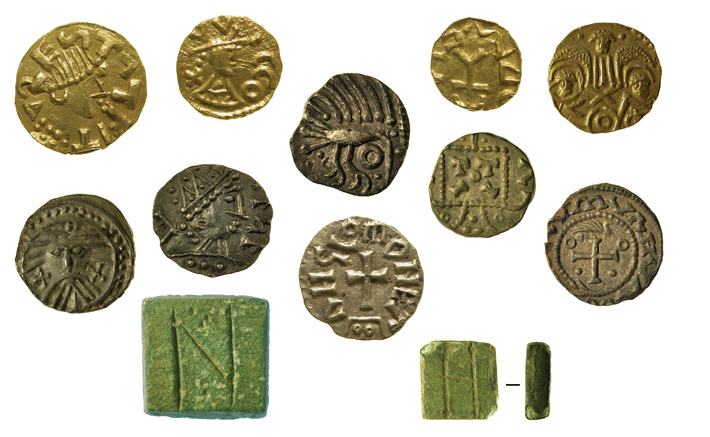 At Rendlesham teams of archaeologists and volunteers have surveyed a research area encompassing more than 400 acres, using a variety of methods, mainly systematic metal detection and magnetometry. More than 3,500 finds have been recorded, dating from the prehistoric period through the modern age. However, an overwhelming concentration of Anglo-Saxon material indicates the existence of a major settlement in Rendlesham, and, for the first time, conclusive evidence of the site’s long association with the kings of Sutton Hoo.
At Rendlesham teams of archaeologists and volunteers have surveyed a research area encompassing more than 400 acres, using a variety of methods, mainly systematic metal detection and magnetometry. More than 3,500 finds have been recorded, dating from the prehistoric period through the modern age. However, an overwhelming concentration of Anglo-Saxon material indicates the existence of a major settlement in Rendlesham, and, for the first time, conclusive evidence of the site’s long association with the kings of Sutton Hoo.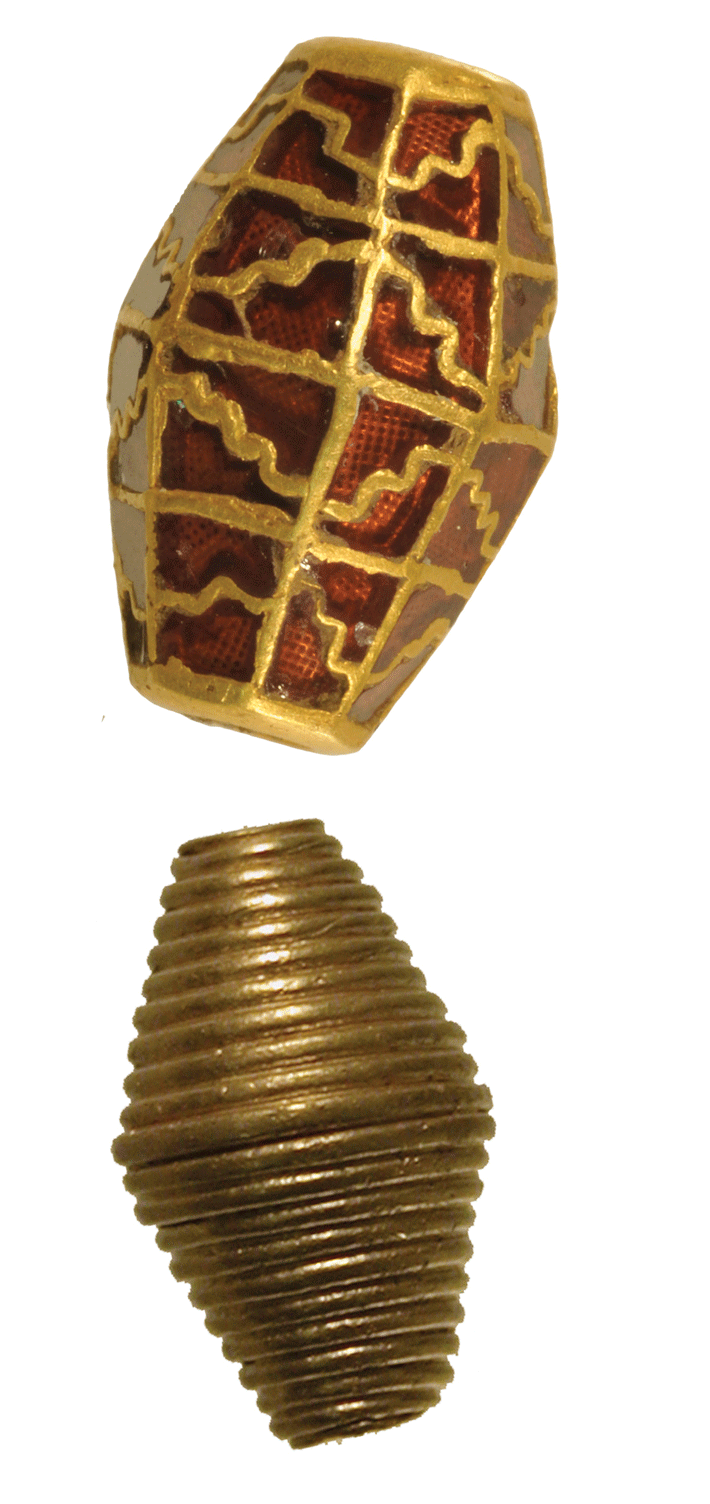 The 125-acre settlement site is significantly larger than any other known contemporary rural Anglo-Saxon site in England. Although evidence shows that it was occupied from approximately 100 B.C. until today, Rendlesham flourished from the sixth to eighth centuries, a period that coincides with the Sutton Hoo burials. While some objects found in Rendlesham, such as jewelry, gold buckles, and brooches, attest to the wealth and elite status of some of its residents, the diversity of artifacts indicates that royalty were not its only inhabitants. Rendlesham, archaeologists believe, was much more than a “royal village” for East Anglian kings, and functioned as trading post, market, and general assembly center for the region at large. The king was also likely to have had estates in the area other than the one at Rendlesham and would have circulated among them to make contact with the local populations. “The discoveries at Rendlesham are of international significance and, like all new information, are forcing us to reconsider what we think we know. Such a rich, extensive and long-lived central place is something entirely new in the archaeology of the Anglo-Saxon kingdoms,” says Christopher Scull of Cardiff University and University College London, one of the project’s archaeological advisors.
The 125-acre settlement site is significantly larger than any other known contemporary rural Anglo-Saxon site in England. Although evidence shows that it was occupied from approximately 100 B.C. until today, Rendlesham flourished from the sixth to eighth centuries, a period that coincides with the Sutton Hoo burials. While some objects found in Rendlesham, such as jewelry, gold buckles, and brooches, attest to the wealth and elite status of some of its residents, the diversity of artifacts indicates that royalty were not its only inhabitants. Rendlesham, archaeologists believe, was much more than a “royal village” for East Anglian kings, and functioned as trading post, market, and general assembly center for the region at large. The king was also likely to have had estates in the area other than the one at Rendlesham and would have circulated among them to make contact with the local populations. “The discoveries at Rendlesham are of international significance and, like all new information, are forcing us to reconsider what we think we know. Such a rich, extensive and long-lived central place is something entirely new in the archaeology of the Anglo-Saxon kingdoms,” says Christopher Scull of Cardiff University and University College London, one of the project’s archaeological advisors.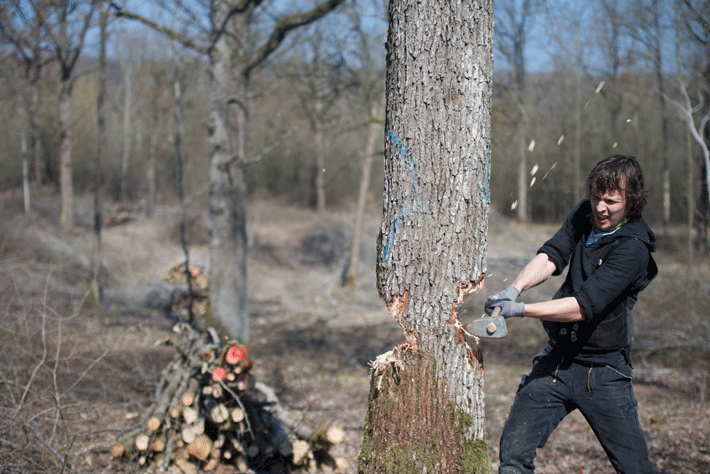
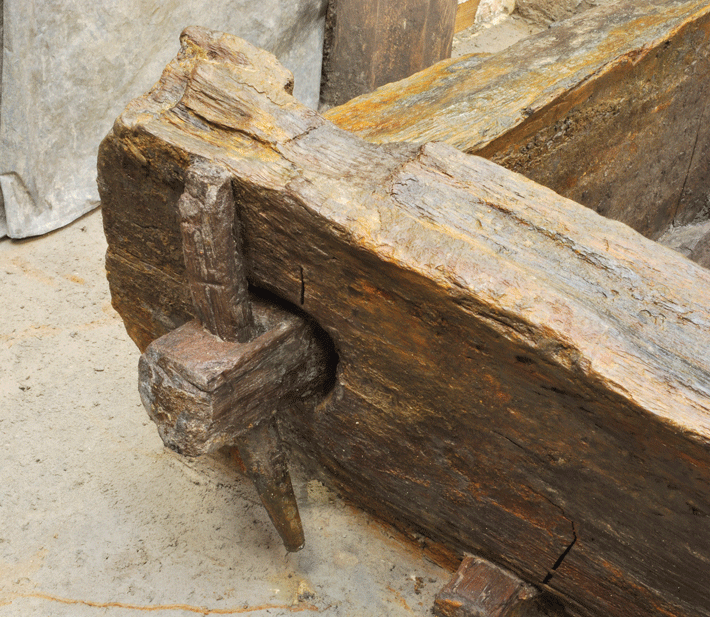 The experiment marked the beginning of a significant shift in the way archaeologists thought about early Europeans and their tools. “The old view was that Neolithic people were more or less ape-men,” Elburg says. “It was a very slow process, but eventually people became aware that the Stone Age was not primitive, and that Stone Age tools were not crude blunt-force instruments, but sophisticated in their own way.”
The experiment marked the beginning of a significant shift in the way archaeologists thought about early Europeans and their tools. “The old view was that Neolithic people were more or less ape-men,” Elburg says. “It was a very slow process, but eventually people became aware that the Stone Age was not primitive, and that Stone Age tools were not crude blunt-force instruments, but sophisticated in their own way.”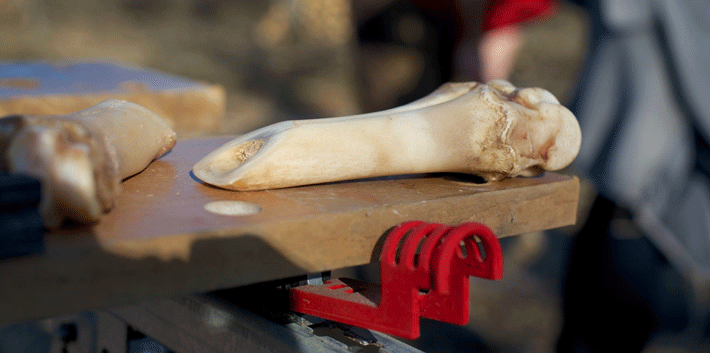 Schweizer-Strobel has spent years examining wood, recovered at the bottom of Lake Constance, from the remains of a Neolithic settlement called Hornstaad-Hoernle, which was located on the Rhine River at the northern foot of the Alps some 6,000 years ago. Hornstaad-Hoernle is one of more than 1,000 known “pile-dwelling” settlements, which were built on prehistoric lakeshores using timber pilings to lift houses above the water. Thanks to oxygen–free conditions at the bottom of some lakes, the pilings and wood debris that dropped into the water from the settlements provide well-preserved evidence of prehistoric woodworking. “I have an unbelievable quantity of chips and waste,” says Schweizer-Strobel. “Take them out of the water and you can see every tool mark. If the ax was starting to get chipped or dull, you can see even that in the wood.”
Schweizer-Strobel has spent years examining wood, recovered at the bottom of Lake Constance, from the remains of a Neolithic settlement called Hornstaad-Hoernle, which was located on the Rhine River at the northern foot of the Alps some 6,000 years ago. Hornstaad-Hoernle is one of more than 1,000 known “pile-dwelling” settlements, which were built on prehistoric lakeshores using timber pilings to lift houses above the water. Thanks to oxygen–free conditions at the bottom of some lakes, the pilings and wood debris that dropped into the water from the settlements provide well-preserved evidence of prehistoric woodworking. “I have an unbelievable quantity of chips and waste,” says Schweizer-Strobel. “Take them out of the water and you can see every tool mark. If the ax was starting to get chipped or dull, you can see even that in the wood.”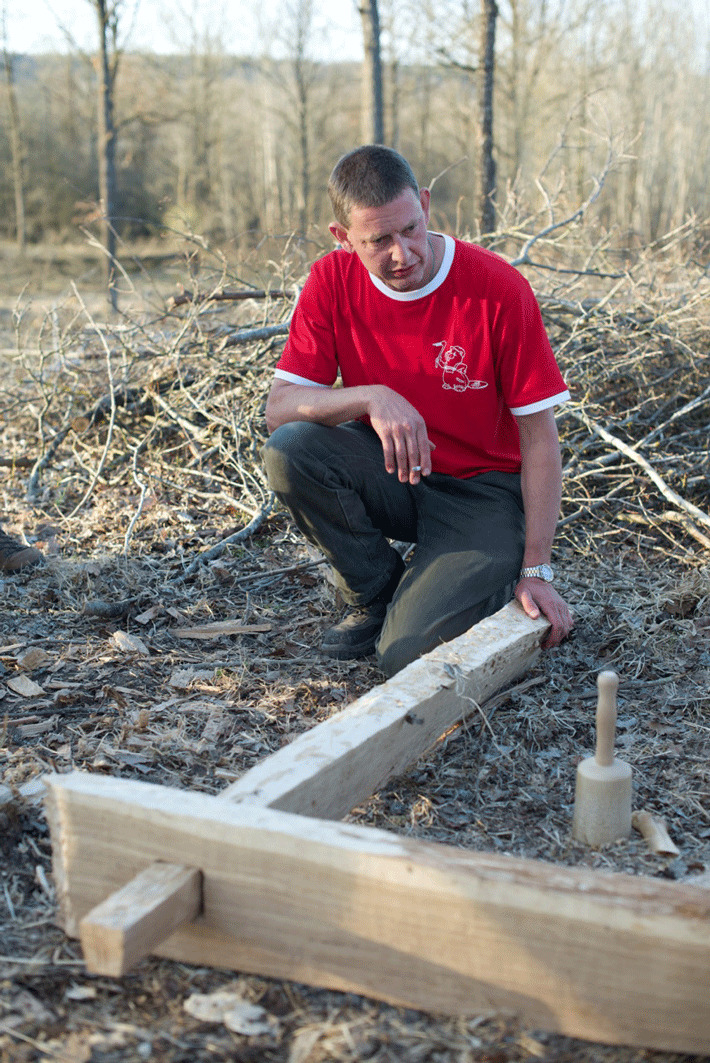 As the day wears on, a pattern of labor begins to emerge. In one area, a trio of toppled trees is being split using wooden wedges and mallets. Nearby, long sections of timber are stripped of bark and fashioned into beams and boards. The final stop is a cluster of craftsmen wielding wooden mallets and sharpened bone chisels to make the joints. Overseeing the last station is Anja Probst, a graduate student at the University of Freiburg who specializes in prehistoric bone tools. It turns out that “Stone Age” is something of a misnomer.
As the day wears on, a pattern of labor begins to emerge. In one area, a trio of toppled trees is being split using wooden wedges and mallets. Nearby, long sections of timber are stripped of bark and fashioned into beams and boards. The final stop is a cluster of craftsmen wielding wooden mallets and sharpened bone chisels to make the joints. Overseeing the last station is Anja Probst, a graduate student at the University of Freiburg who specializes in prehistoric bone tools. It turns out that “Stone Age” is something of a misnomer.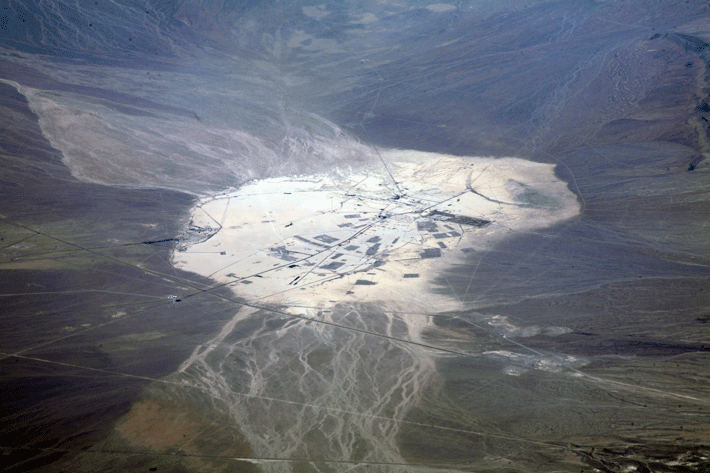
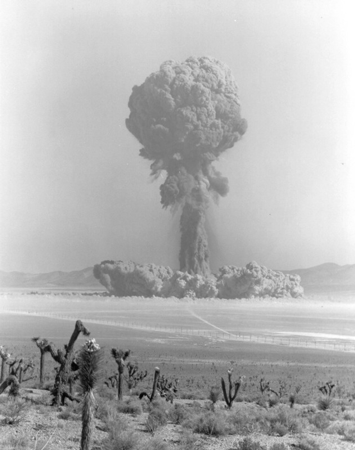 The material remains at the Test Site represent just how little was known about the power and impact of nuclear weapons technology—even after it had been rushed into use in Japan. Subsequently, tests would be conducted to assess the effects of bombs, simulate nuclear warfare, better understand the effects of radiation, and, of course, build bigger and better bombs. Additional research efforts examined the storage of nuclear waste and the application of nuclear technology to missiles, space travel, and large-scale engineering projects, such as canals. On Frenchman Flat, many of the atmospheric tests were focused on “survivability,” specifically how different structures and materials respond to nuclear blasts. There are, for example, the remains of glass houses, a “motel” (to test structural partitions and masonry), a small house cheekily named “Joe’s Bar,” and dozens of other structures.
The material remains at the Test Site represent just how little was known about the power and impact of nuclear weapons technology—even after it had been rushed into use in Japan. Subsequently, tests would be conducted to assess the effects of bombs, simulate nuclear warfare, better understand the effects of radiation, and, of course, build bigger and better bombs. Additional research efforts examined the storage of nuclear waste and the application of nuclear technology to missiles, space travel, and large-scale engineering projects, such as canals. On Frenchman Flat, many of the atmospheric tests were focused on “survivability,” specifically how different structures and materials respond to nuclear blasts. There are, for example, the remains of glass houses, a “motel” (to test structural partitions and masonry), a small house cheekily named “Joe’s Bar,” and dozens of other structures.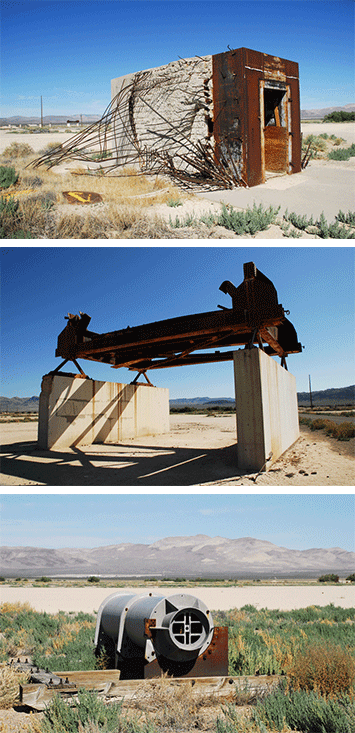 The Department of Energy agreed. In 1991, Beck worked with an architect to document her first twentieth-century structures, and she’s been doing Cold War archaeology ever since. Year after year, archaeologists from the DRI have walked transects across the vast landscape, documented historical remains, and conducted targeted surveys of buildings and structures—almost 2,000 sites so far, representing less than 5 percent of the Test Site. Documenting it all, Beck says, would take lifetimes. “You’d think that after more than 20 years we would have seen it all, but that’s far from the truth,” she says. “We still find things—it’s really amazing.”
The Department of Energy agreed. In 1991, Beck worked with an architect to document her first twentieth-century structures, and she’s been doing Cold War archaeology ever since. Year after year, archaeologists from the DRI have walked transects across the vast landscape, documented historical remains, and conducted targeted surveys of buildings and structures—almost 2,000 sites so far, representing less than 5 percent of the Test Site. Documenting it all, Beck says, would take lifetimes. “You’d think that after more than 20 years we would have seen it all, but that’s far from the truth,” she says. “We still find things—it’s really amazing.”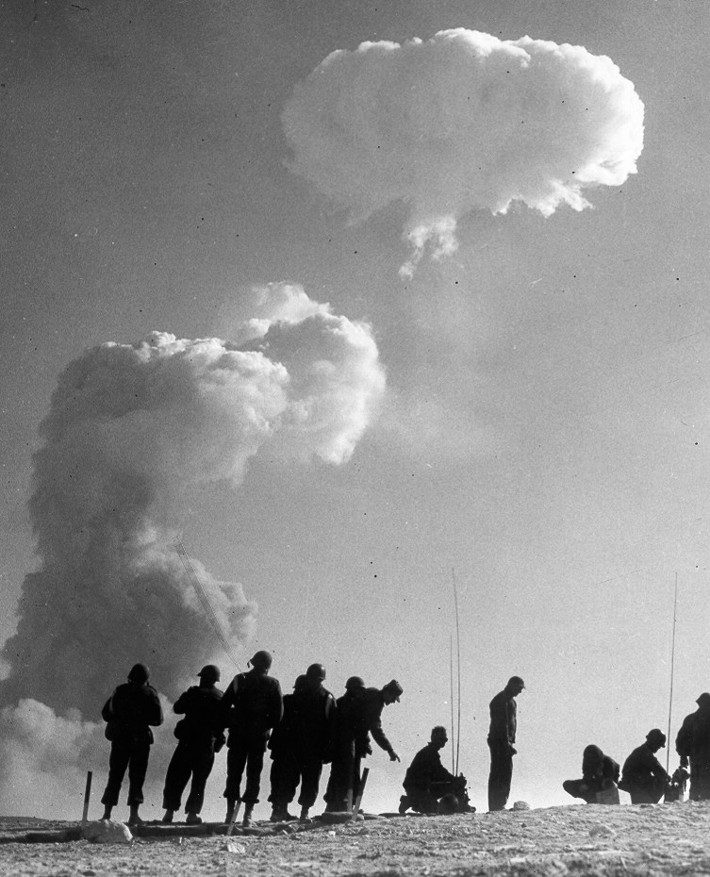 But pigs weren’t the only ones exposed to radiation. During the 1950s, 60,000 troops passed through the Test Site. Wearing helmets, gas masks, and ordinary fatigues, many crouched in trenches during the blasts, and later advanced closer—simulating ground warfare in an all-out nuclear conflagration. Another shot in Operation Plumbbob, Smoky, a 44-kiloton device detonated on a tower on Yucca Flat, on the other side of the Test Site, on August 31, 1957, involved 3,000 U.S. servicemen on the ground.
But pigs weren’t the only ones exposed to radiation. During the 1950s, 60,000 troops passed through the Test Site. Wearing helmets, gas masks, and ordinary fatigues, many crouched in trenches during the blasts, and later advanced closer—simulating ground warfare in an all-out nuclear conflagration. Another shot in Operation Plumbbob, Smoky, a 44-kiloton device detonated on a tower on Yucca Flat, on the other side of the Test Site, on August 31, 1957, involved 3,000 U.S. servicemen on the ground.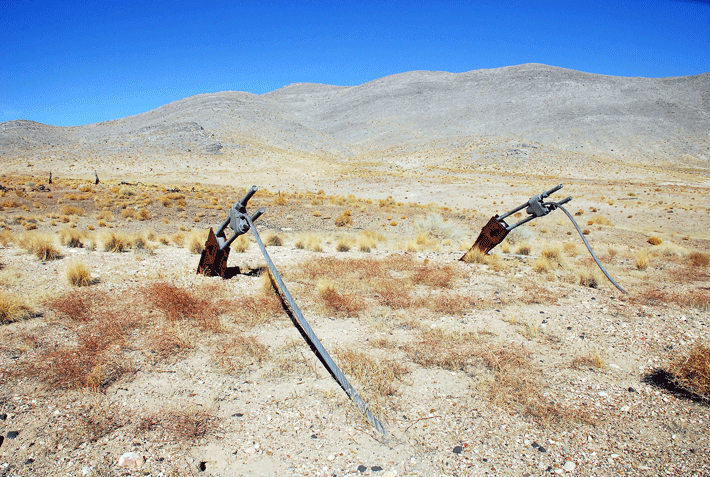 More than anything, Beck and the DRI are adding a tangible component to this vast written record, much of which is classified. Their work provides another means of understanding a time defined by fear and uncertainty, but also optimism. It’s not, Beck says, that these materials are going to be lost, as the site is still heavily protected and most of the remains are durable. It is rather that they need to be found, and then inventoried, so that there is an index of knowledge as memories of the age of atomic experimentation fade.
More than anything, Beck and the DRI are adding a tangible component to this vast written record, much of which is classified. Their work provides another means of understanding a time defined by fear and uncertainty, but also optimism. It’s not, Beck says, that these materials are going to be lost, as the site is still heavily protected and most of the remains are durable. It is rather that they need to be found, and then inventoried, so that there is an index of knowledge as memories of the age of atomic experimentation fade.
